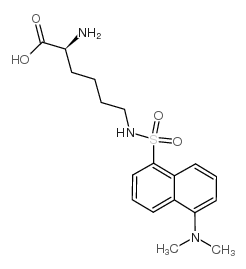Membrane structure and the tenuously maintained resistance to staining with N epsilon-dansyl-L-lysine shown by many cells.
G M Humphries, J P Lovejoy
Index: J. Membr. Biol. 77(2) , 115-22, (1984)
Full Text: HTML
Abstract
The ability to resist staining by N epsilon-dansyl-L-lysine is tenuously maintained in the majority of live nucleated cells taken from tissues concerned with immune function. Resistance is lost under a variety of nonphysiological conditions known to, or likely to, cause protein denaturation or aggregation. In contrast to that of dansyl-gamma-aminobutyrate, the fluorescence intensity of N epsilon-dansyl-L-lysine is only weakly enhanced by native proteins. This is further reduced on denaturation or aggregation of the proteins. It is unlikely, therefore, that cellular uptake of, and staining by, N epsilon-dansyl-L-lysine is a direct consequence of membrane protein denaturation/aggregation but may result from a decrease in protein-phospholipid interactions leading to formation of phospholipid domains. Previous work has indicated that such features are stained by N epsilon-dansyl-L-lysine (Humphries, G.M.K., Lovejoy, J.P., 1983, Biophys. J. 42:307-310; Humphries, G.M.K., Lovejoy, J.R., 1983, Biochem. Biophys. Res. Commun. 111:768-774). Although it appears likely that passage through a dansyl-lysine-staining state is a common, if not universal, prelude to cell death (as monitored by uptake of trypan blue), not all cells that lose resistance to dansyl-lysine staining are moribund. Resistance to staining is also lost by macrophages on binding to solid substrates and multivalent ligands. The possible physiological significance of this is discussed.
Related Compounds
| Structure | Name/CAS No. | Molecular Formula | Articles |
|---|---|---|---|
 |
Dansyllysine
CAS:1101-84-4 |
C18H25N3O4S |
|
Determination of binding conformations of drugs to human ser...
1998-03-01 [J. Pharm. Sci. 87 , 379-386, (1998)] |
|
Cholesterol-free phospholipid domains may be the membrane fe...
1983-03-16 [Biochem. Biophys. Res. Commun. 111(2) , 768-74, (1983)] |
|
The use of dansyl lysine to assess heat damage and thermotol...
1988-05-01 [Int. J. Radiat. Oncol. Biol. Phys. 14(5) , 983-8, (1988)] |
|
Measurement of DNA and antigen expression of live cells usin...
1990-01-01 [Cytometry 11(4) , 533-8, (1990)] |
|
Dansyl lysine: a structure-selective fluorescent membrane st...
1983-06-01 [Biophys. J. 42(3) , 307-10, (1983)] |